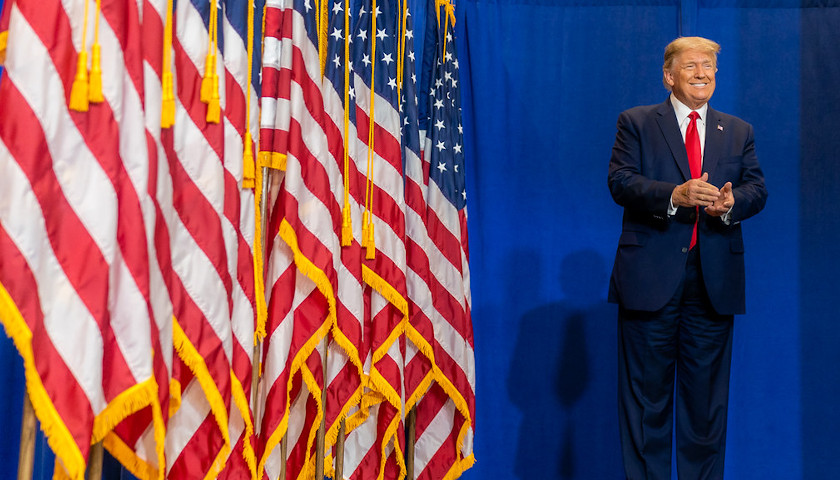by Conrad Black
The tense and critical period of recounting and challenging the presidential election results in several states has brought to a climax the great struggle between the Trump phenomenon and the different constituent elements of the post-Reagan bipartisan political establishment.
As it stands now, fewer than 40,000 votes switched from the Democratic nominee Joe Biden to Donald Trump in Pennsylvania, Georgia, and Arizona would give Trump the election 279 electoral votes to Biden’s 259. If Biden retained Pennsylvania, and only 25,000 votes shifted from Biden to Trump in Arizona, Georgia, and Wisconsin, the Electoral College would be tied 269 each, and Trump would be reelected by the House of Representatives where each state delegation casts a single vote; Alaska’s congressman has equal weight to California’s 53. The Senate, in that scenario, elects the vice president, and the Republican majority would reelect Vice President Mike Pence.
In 2016, if about 40,000 votes had switched from Trump to Hillary Clinton in Pennsylvania, Michigan, and Wisconsin, she would have won. On the other hand, even with that switch, if just 16,000 voters in Nevada and New Hampshire had moved from Clinton to Trump he would still have won with 270 electoral votes to Clinton’s 268.
There have been endless references over the oast two weeks to the decision of the 2000 presidential election by only 537 votes in the state of Florida in favor of George W. Bush over Al Gore. In 1960, John F. Kennedy won Illinois by 9,000 votes out of 4.76 million cast, won Missouri also by 9,000 votes out of nearly 2 million cast in that state, and had a combined plurality in Nevada and New Mexico of only 5,000 votes out of 420,000 votes counted. If only 12,000 well-placed votes in those four states had switched from Kennedy to Richard Nixon, Nixon would have been elected.
There have been many American presidential elections that have been desperately close, including 1848 (Zachary Taylor), 1876 (Rutherford Hayes), 1880 (James A. Garfield), and 1916 (Woodrow Wilson). There is nothing uncommon about them nor anything wrong with them. But this election, even before the results of judicial reviews and recounts are known, has three unique aspects.
First, the substantial evidence of vote-tampering vastly exceeds, in quantity and prima facie evidence, anything that has been seen before in a U.S. election. This is evidently the result of legislative responses to the COVID-19 pandemic, in particular the practice in a number of states of a general mailing of ballots, unsolicited, to the entire list of registered voters.
We’ve heard comment ad nauseam about the almost unlimited possibility of abuse in such a system, compounded by relaxation of voter accuracy verification standards, suspension of genuine oversight capacity in vote counting, concentration of suspect voting patterns in swing states governed by Democrats, early suspension of vote counting followed by miraculous “drops” of large and uneven quantities of votes in the dead of night, and a farrago of other manipulative measures. The most controversial of these in the last week was unsuccessful Georgia Democratic gubernatorial candidate Stacy Abrams’ apparently successful opposition to a reliable ballot verification procedure.
Everyone knows there are hundreds of thousands of questionable ballots floating around, and yet the Trump-hating media are raging at the president for being a poor sport. Compare this to Hillary Clinton four years ago, a woman who could not bring herself to make a public statement on Election Night and has spent a large part of every day since complaining that Trump stole the election in tandem with the Russian government and with the unwitting assistance of James Comey.
The civilized anti-Trumpers, since the president is only asking that all legal votes be counted and no illegal ones, urge that he be indulged while laboriously restating that hard evidence has yet to be found. It can only be found by an intensive examination of the ballots, so that criticism amounts to nonsense.
The second unique aspect of this critical tipping point is that it is not just between two candidates of the traditional principal political parties struggling for mastery of the same system. It is the post-Reagan bipartisan political class conducting a supreme effort to protect their position from the Trump onslaught. Trump shocked them by winning four years ago and he has spent the intervening years enacting his program against fierce resistance, while his enemies have never ceased for one day to try to reverse the results of the last election, undermine his ability to govern, and prepare and wage a fanatical, no-holds-barred, volcanic mudslinging operation against him.
From the initial confection of the phony Trump-Russia allegations through a fatuous impeachment procedure, to the representation of the COVID-19 crisis response as an act of attempted genocide even if by negligence on the part of the president, it has been total war, take-no-prisoners, no quarter given or asked. The media have almost unanimously made the Democratic campaign while the enervated and unprepossessing nominee, Joe Biden, has invoked the pandemic to stay almost completely out of sight.
Meanwhile the anti-Trump coalition includes the urban guerrillas and hooligans who rioted all summer in Democratic governed states and cities across the country and were never mentioned at the Democratic national convention. It also included the great rich of Wall Street and Silicon Valley who, for a variety of cultural and economic reasons, disapprove of Trump’s arousing of middle and working class discontent.
They have pilloried Trump as both an aspiring Hitler (most recently CNN’s Christiane, Amanpour) and a demiurge of buffoonery. (This is incongruous: whatever else he was, Hitler was not a buffoon.) Nothing unites this vast anti-Trump coalition except its dislike of Trump and the Democratic campaign offered no coherent program for the election, as Biden’s position, expressed in the first debate, is that since his nomination, the party’s program is what he says it is, not the semi-Marxist manifesto that he and Senator Bernie Sanders agreed it would be. It is a fragile coalition facing an immense monolith of Trump voters.
The Trump campaign to overthrow the political establishment may have stalled, but even if it is narrowly evicted from the White House, and even if the election result is not evidently based on fraudulent dumps of invalid ballots, Trump is not going away. His following is unlikely to defect to anyone else, and so non-galvanizing a leader as Biden at the head of so fissiparous a coalition will not easily deflect the 73 million Trump voters or their formidable convener-in-chief from continuing the battle after no more of a hiatus than Trump’s enemies gave him four years ago.
The Democrats are unlikely to retain their now very tenuous control of the House of Representatives in the midterm elections, and it would be the most astonishingly pleasant surprise in the history of American elections if a Biden Administration turned out to be competent and widely supported. They will not win again with a referendum on whether the country likes Trump. They will have to present an alternative.
Trump could be an unprecedentedly effective chief of the opposition. This would be true especially if he made a serious effort to eliminate those personality traits that are so irritating to so many people and which probably account for at least 10 percent of the votes cast for Biden in the late election. This epic contest between Donald Trump and the political establishment is far from over.
– – –
Conrad Black has been one of Canada’s most prominent financiers for 40 years, and was one of the leading newspaper publishers in the world as owner of the British telegraph newspapers, the Fairfax newspapers in Australia, the Jerusalem Post, Chicago Sun-Times and scores of smaller newspapers in the U.S., and most of the daily newspapers in Canada. He is the author of authoritative biographies of Franklin D. Roosevelt and Richard Nixon, one-volume histories of the United States and Canada, and most recently of Donald J. Trump: A President Like No Other. He is a member of the British House of Lords as Lord Black of Crossharbour.




